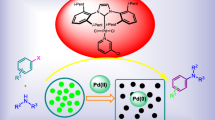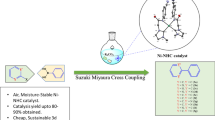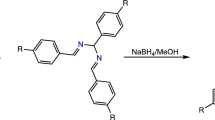The reaction of 1-ethoxycarbonylmethyl-5,5,7,7-tetramethyl-2-oxo-tetrahydroimidazo[1,5-b]oxadiazol-6-oxyl with the weakly basic nucleophiles NaN3, NaCN, KF, KBr, KCl and NaNO2 has been studied. It was shown for the first time that, as in the case of NaOH and MeONa, the reaction occurs with opening of the oxadiazolone ring to form exo-N-substituted amidines. It was shown that the weakly basic nucleophiles readily react with substrates which contain a substituent sensitive to attack by such nucleophiles as NaOH or MeONa. The effect of the nature of the nucleophiles on the reaction course for opening of the oxadiazolone ring was also studied. It was found that the reactivity of the nucleophiles in DMSO changes in the series F− > CN− > N –3 >NO −2 > Cl− > Br− and qualitatively correlates with their basicities in this solvent. Examination of the effect of the ratio of the reagents on the degree of conversion of the starting oxadiazolone has shown that a quantity of nucleophiles less than one equivalent also allowed the cleavage reaction of the oxadiazolone heterocycle to go to completion through just increasing the reaction time. The experimental data obtained lends support to the proposed reaction scheme.
Similar content being viewed by others
References
D. S. C. Black, R. F. Crozier, and V. C. Davis, Synthesis, 4, 205 (1975).
N. Coskun and A. Parlar, Synth. Commun., 36, 997 (2006).
H. Seidl, R. Huisgen, and R. Grashey, Chem. Ber. 102, 926 (1969).
T. Hisano, S. Yoshikawa, and K. Muraoka, Chem. Pharm. Bull., 22, 1611 (1974).
J. Goerdeler and R. Schimpf, Chem. Ber., 106, 1496 (1973).
C. J. Wilkerson and F. D. Green, J. Org. Chem., 40, 3112 (1975).
V. G. Granik, Usp. Khim., 52, 669 (1983).
V. A. Dorokhov and M. A. Prezent, Izv. Akad Nauk, Ser. Khim., 888 (1994).
S. Dagorne, I. A. Guzei, M. P. Coles, and R. F. J. Jordan, J. Amer. Chem. Soc., 122, 274 (2000).
J. Barker and M. Kilner, Coord. Chem. Rev., 133, 219 (1994).
J. A. Tucker, T. L. Clyton, C. G. Chidester, M. W. Schulz, L. E. Harrington, S. J. Conrad, Y. Yagi, N. L. Oien. D. Yurek, and M.-S. Kuo, Bioorg. Med. Chem., 8, 601 (2001).
V. V. Khramtsov and L. B. Volodarsky in L. J. Berliner (editor), Spin Labelling: The Next Millennium: Biological Magnetic Resonance, Vol. 14, Plenum Press, New York (1998), p.109.
T. A. Berezina, V. V. Martin, L. B. Volodarsky, V. V. Khramtsov, and L. M. Vainer, Bioorg. Khim., 16, 262 (1990).
J. F. Polienko, T. Schanding, Y. V. Gatilov, I. A. Grigor’ev, and M. A. Voinov, J. Org. Chem., 73, 502 (2008).
T. A. Berezina, V. A. Reznikov, and L. B. Volodarsky, Tetrahedron, 49, 10693 (1993).
F. G. Bordwell, Acc. Chem. Res., 21, 456 (1988).
J. O. Edwards and R. G. Pearson, J. Am. Chem. Soc., 84, 16 (1962).
R. G. Parr and R. G. Pearson, J. Am. Chem. Soc., 105, 7512 (1983).
S. A. Shevelev, Usp. Khim., 39, 1773 (1970).
E. A. S. Cavell, J. Chem. Soc., 4217 (1958).
S. Winstein, L. G. Savedoff, S. Smith, I. D. R. Stevens, and J. S. Gall, Tetrahedron Lett., 1, 24 (1960).
R. F. Rodewald, K. Mahendran, J. L. Bear, and R. Fuchs, J. Amer. Chem. Soc., 90, 6698 (1968).
J. Korkisch, Handbook of Ion Exchange Resins: Their Application to Inorganic Analytical Chemistry, Vol. 1, CRC Press Inc., Boca Raton, Florida (1989).
M. Balakirev, V. V. Khramtsov, T. A. Berezina, V. V. Martin, and L. B. Volodarsky, Synthesis, 12, 1223 (1992).
Author information
Authors and Affiliations
Corresponding author
Additional information
Dedicated to Academician B. A. Trofimov in his 70th jubilee.
Translated from Khimiya Geterotsiklicheskikh Soedinenii, No. 1, pp. 71–78, January, 2009.
Rights and permissions
About this article
Cite this article
Polienko, Y.F., Grigor’yev, I.A. & Voinov, M.A. Synthesis of N'-substituted amidines through the cleavage an oxadiazolone heterocycle by weakly basic nucleophiles. Effect of the nature of the nucleophile and of the nucleophile/substrate molar ratio. Chem Heterocycl Comp 45, 59–65 (2009). https://doi.org/10.1007/s10593-009-0226-6
Received:
Published:
Issue Date:
DOI: https://doi.org/10.1007/s10593-009-0226-6




